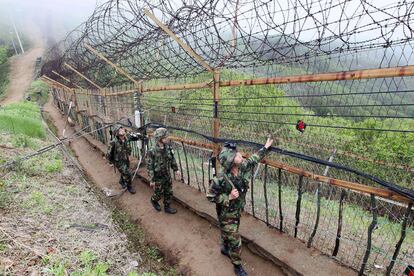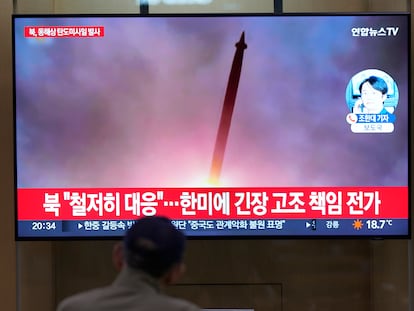An American soldier is detained by North Korea after crossing its heavily armed border
There were no immediate details about how or why the soldier crossed the heavily fortified border or whether the soldier was on duty

An American soldier crossed the heavily armed border from South Korea into North Korea “willfully and without authorization,” U.S. officials said Tuesday, becoming the first American detained in the North in nearly five years amid heightened tensions over its nuclear program.
There were no immediate details about why or how the soldier crossed the border, or whether the soldier was on duty. The four U.S. officials spoke on the condition of anonymity to discuss the matter ahead of a public announcement.
The American-led U.N. Command overseeing the area tweeted earlier Tuesday that the detained U.S. citizen was on a tour of the Korean border village of Panmunjom. The U.S. military in South Korea said in a statement that he “willfully and without authorization” crossed the military demarcation line into North Korea.
It said he is believed to be in North Korean custody and that the U.N. Command is working with its North Korean counterparts to resolve the incident. North Korea’s state media didn’t immediately report on the border crossing.
Cases of Americans or South Koreans defecting to North Korea are rare, though more than 30,000 North Koreans have fled to South Korea to avoid political oppression and economic difficulties since the end of the 1950-53 Korean War.
Panmunjom, located inside the 248-kilometer (154-mile) -long Demilitarized Zone, has been jointly overseen by the U.N. Command and North Korea since its creation at the close of the Korean War. Bloodshed and gunfire have occasionally occurred there, but it has also been a venue for numerous talks and is a popular tourist spot.
Known for its blue huts straddling concrete slabs that form the demarcation line, Panmunjom draws visitors from both sides who want to see the Cold War’s last frontier. No civilians live at Panmunjom. In the past, North and South Korean soldiers faced off within meters (yards) of each other.
Tours to the southern side of the village reportedly drew around 100,000 visitors a year before the pandemic, when South Korea restricted gatherings to slow the spread of COVID-19. The tours resumed fully last year. During a short-lived period of inter-Korean engagement in 2018, Panmunjom was one of the border sites that underwent mine-clearing operations by North and South Korean army engineers as the Koreas vowed to turn the village into a “peace zone” where tourists from both sides could move around with more freedom.
In November 2017, North Korean soldiers fired 40 rounds as one of their colleagues raced toward the South. The soldier was hit five times before he was found beneath a pile of leaves on the southern side of Panmunjom. He survived and is now in South Korea.
The most famous incident at Panmunjom happened in August 1976, when two American army officers were killed by ax-wielding North Korean soldiers. The U.S. officers had been sent to trim a 40-foot (12-meter) tree that obstructed the view from a checkpoint. The attack prompted Washington to fly nuclear-capable B-52 bombers toward the DMZ to intimidate North Korea.
Panmunjom also is where the armistice that ended the Korean War was signed. That armistice has yet to be replaced with a peace treaty, leaving the Korean Peninsula technically in a state of war. The United States still stations about 28,000 troops in South Korea.
There have been a small number of U.S. soldiers who went to North Korea during the Cold War, including Charles Jenkins, who deserted his army post in South Korea in 1965 and fled across the DMZ. He appeared in North Korean propaganda films and married a Japanese nursing student who had been abducted from Japan by North Korean agents. He died in Japan in 2017.
But in recent years, some American civilians have been arrested in North Korea after allegedly entering the country from China. They were later convicted of espionage, subversion and other anti-state acts, but were often released after the U.S. sent high-profile missions to secure their freedom.
In May 2018, North Korea released three American detainees -– Kim Dong Chul, Tony Kim and Kim Hak Song -– who returned to the United Sates on a plane with then-Secretary of State Mike Pompeo during a short-lived period of warm relations between the longtime adversaries. Later in 2018, North Korea said it expelled American Bruce Byron Lowrance. Since his ouster, there have been no reports of other Americans detained in North Korea before Tuesday’s incident.
The 2018 releases came as North Korean leader Kim Jong-un was engaged in nuclear diplomacy with then-President Donald Trump. The high-stakes diplomacy collapsed in 2019 amid wrangling over U.S.-led sanctions on North Korea.
Their freedoms were a striking contrast to the fate of Otto Warmbier, an American university student who died in 2017 days after he was released by North Korea in a coma after 17 months in captivity. Warmbier and other previous American detainees in North Korea were imprisoned over a variety of alleged crimes, including subversion, anti-state activities and spying.
The United States, South Korea and others have accused North Korea of using foreign detainees to wrest diplomatic concessions. Some foreigners have said after their release that their declarations of guilt were coerced while in North Korean custody.
Tuesday’s border crossing happened amid high tensions over North Korea’s barrage of missile tests since the start of last year. A U.S. nuclear-armed submarine visited South Korea on Tuesday for the first time in four decades in deterrence against North Korea.
Sign up for our weekly newsletter to get more English-language news coverage from EL PAÍS USA Edition
Tu suscripción se está usando en otro dispositivo
¿Quieres añadir otro usuario a tu suscripción?
Si continúas leyendo en este dispositivo, no se podrá leer en el otro.
FlechaTu suscripción se está usando en otro dispositivo y solo puedes acceder a EL PAÍS desde un dispositivo a la vez.
Si quieres compartir tu cuenta, cambia tu suscripción a la modalidad Premium, así podrás añadir otro usuario. Cada uno accederá con su propia cuenta de email, lo que os permitirá personalizar vuestra experiencia en EL PAÍS.
¿Tienes una suscripción de empresa? Accede aquí para contratar más cuentas.
En el caso de no saber quién está usando tu cuenta, te recomendamos cambiar tu contraseña aquí.
Si decides continuar compartiendo tu cuenta, este mensaje se mostrará en tu dispositivo y en el de la otra persona que está usando tu cuenta de forma indefinida, afectando a tu experiencia de lectura. Puedes consultar aquí los términos y condiciones de la suscripción digital.
More information
Archived In
Últimas noticias
Most viewed
- Reinhard Genzel, Nobel laureate in physics: ‘One-minute videos will never give you the truth’
- Oona Chaplin: ‘I told James Cameron that I was living in a treehouse and starting a permaculture project with a friend’
- Pablo Escobar’s hippos: A serious environmental problem, 40 years on
- Why we lost the habit of sleeping in two segments and how that changed our sense of time
- Chevy Chase, the beloved comedian who was a monster off camera: ‘Not everyone hated him, just the people who’ve worked with him’










































